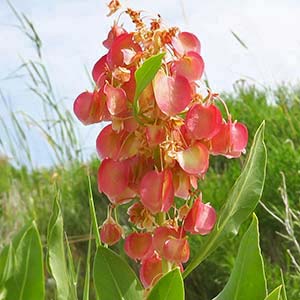Rumex mexicanus
Rumex venosus
Mexican dock, Mexican willow, Mexican willow or dock
rumex veine, vein dock, veiny dock, wild-begonia, wing dock
erect or ascending, usually producing axillary shoots below 1st-order inflorescence or at proximal nodes, 30–60(–90) cm.
ascending or, rarely, erect, usually producing axillary shoots near base, (10–)15–30(–40) cm.
blades light green to yellowish green, linear-lanceolate, occasionally lanceolate, 6–14 × 1–3.5(–4) cm, usually ca. 5–7 times as long as wide, widest near middle, thin, not coriaceous, base cuneate, margins entire, flat or undulate, apex acute or attenuate.
blades ovate-elliptic, obovate-elliptic, or ovate-lanceolate, (2–)4–12(–15) × 1–5(–6) cm, subcoriaceous, base narrowly to broadly cuneate, margins entire, flat or slightly undulate, apex acute or acuminate.
terminal and axillary, terminal usually occupying distal 1/5–1/3 of stem, rather dense or interrupted in proximal 1/2, usually broadly paniculate (branches simple or with few 2d-order branches).
terminal and axillary, usually occupying distal 2/3 of stem/shoot, usually dense, or interrupted in proximal part, broadly paniculate.
articulated in proximal 1/3 or almost near base, filiform (thickened distally), 4–7 mm, not more than 2–2.5 times as long as inner tepals, articulation indistinctly swollen.
articulated near middle, filiform or slightly thickened, (8–)10–16 mm, articulation distinct, slightly swollen.
10–20 in whorls;
inner tepals broadly ovate-triangular, occasionally broadly triangular, 3.5–4.5(–5) × 3.5–4(–5) mm, base truncate or indistinctly cordate, margins entire or indistinctly erose, apex obtuse or subacute;
tubercles 3, equal or subequal (much narrower than inner tepals).
5–15 in whorls;
inner tepals distinctly double-reticulately veined, orbiculate or reniform-orbiculate, 13–18(–20) × (20–)23–30 mm, base deeply emarginate or cordate, margins entire, apex rounded, obtuse, rarely subacute, with short, broadly triangular tip;
tubercles absent, occasionally very small.
brown or dark reddish brown, 2–3 × 1.5–2 mm.
brown or dark brown, 5–7 × 4–6 mm.
= 40.
= 40.
Rumex mexicanus
Rumex venosus
Some authors recognize Rumex mexicanus in the broad sense, including in it many other taxa treated here as separate entities. For consistency, the entities of the R. salicifolius aggregate that are recognized herein are kept separate pending additional taxonomic research.
(Discussion copyrighted by Flora of North America; reprinted with permission.)
Rumex venosus is a distinctive species rarely confused with any other members of the genus. However, I have seen herbarium specimens of it misidentified as R. hymenosepalus, and vice versa.
(Discussion copyrighted by Flora of North America; reprinted with permission.)
- Local floras:
CA,
OR,
WA
- Local Web sites:
CalFlora,
CalPhotos,
Flora NW,
KS Wildflowers,
MN Wildflowers,
PNW Herbaria,
Turner Photog.
WildflowerSearch
iNaturalist (observations)
USDA Plants Database
- LBJ Wildflower Center
- SEINet
- Plants of the World Online
- Encyclopedia of Life
- Wikipedia
- Google Image Search


